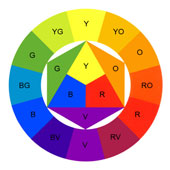Research has shown that colours are an important product characteristic and play an important role in the commercial viability or the sale of the products. However, colours of products, specifically every-day products, are very important not just for influencing sales but also for making products pleasant to use. Attractive products produces positive emotions, causing mental processes to be more creative, and users to be more tolerant of minor difficulties in case of day-to-day products [1].
The colour of a product and its packaging as well as the way it is displayed is usually the first thing that a consumer sights in the showrooms even before inquiring about the product’s features and functions. We sometimes find the less successful product brands using the colour of a successfully established brand in the market selling a similar product to hike its sale. Some colours also get associated with certain products over time and gradually stands for the trust and quality for that brand and product.
The colour to be assigned to a product and its packaging requires research and creative design ideas for its success. The colour of a product should interact with its main use and the users. The colours of the products receive reactions from the viewers, users and buyers and it affects the way we feel about a designed product. We naturally link colour to memories and moods. Although there are no hard and fast rules or right or wrong use of colours, making a bad colour choice for your design will undoubtedly affect its success. The colour may be assigned to a product based on the following criterias:
To stand out amongst other products in the display – Eg. Vanish, stain remover- ‘trust the pink’.

(Image source)
To represent the characteristics product itself.
Eg. coffee packaging is usually dark brown in colour to represent the strong flavour and colour of the coffee beans. The colours of the room fresheners are usually soft and soothing.

(Image source)
To give a message or portray the brand/product’s ethos.
Eg. energy efficient or recycled products are of green (green symbolises environment and sustainability) or natural colours.

(Image source)
To target specific group of consumers.
Eg. Kids are attracted to bright colours, hence the range of kids products are in bright. The teenage products are usually trendy and hip.

A range of bright coloured kids products.


To respond to the function and purpose of the product – eg. safety jackets are bright yellow or orange for high visibility, fire extinguishers are red to symbolise fire, to grab attention and convey alertness.
According to Dave Vogler a product designer in NY there are four areas that colour study for any product must consider. The Four F’s: First impressions, Form, Function, and Fashion.
First Impressions:
Colour psychology plays a key role in product design and marketing, hence it is important to understand the meanings of colour and its psychological and emotional influences on the consumers. As colour conveys different messages to different groups of people, care should be taken when using colours in different settings.
Form:
Clever use of colour can accentuate certain features, drawing attention to them, or minimize other features so aren’t readily noticed. In general, lighter colours show more contrast between light and shadow, so the eye will notice these features more prominently. Bright colours are used to highlight key functions or features.
Function:
Colour is also a part of some firmly established and universally accepted functional interfaces. Once colour enters the picture as a user interface language, the surrounding product should be neutral, so as not to distract the user from noticing interface features.
Fashion:
After the previous colour effects are considered, colour variations usually boil down to fashion and industry trends. Consumer products can edge out their competition with an offering of colours appealing to personal taste.
He further adds, ‘Colour introduces a manufacturing premium- whether it is painted, powder coated, or molded in colour, it will simply cost more to control the colour matching in manufacturing. If there is not financial support behind the decision to create colour variations, it won’t make it into production.” [2]
The process of designing a product and getting it into mass production is a lengthy and time-consuming procedure. Markets often changes their appetite for colours and it is therefore critical to be able to forecast a market’s preferred colour for a given product (colour forecasting) [3].
[1] Norman DA (2004),’Why we love (or hate) everyday things’, NewYork: Basic Books.
[2] http://www.fuelyourproductdesign.com
[3] Diane T and Cassidy T (2005), Colour Forecasting, Blackwell Publishing.

